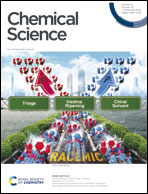Plasmon-enabled N2 photofixation on partially reduced Ti3C2 MXene†
Abstract
Benefiting from the superior conductivity, rich surface chemistry and tunable bandgap, Ti3C2 MXene has become a frontier cocatalyst material for boosting the efficiency of semiconductor photocatalysts. It has been theoretically predicted to be an ideal material for N2 fixation. However, the realization of N2 photofixation with Ti3C2 as a host photocatalyst has so far remained experimentally challenging. Herein, we report on a sandwich-like plasmon- and an MXene-based photocatalyst made of Au nanospheres and layered Ti3C2, and demonstrate its efficient N2 photofixation in pure water under ambient conditions. The abundant low-valence Ti (Ti(4−x)+) sites in partially reduced Ti3C2 (r-Ti3C2) produced by surface engineering through H2 thermal reduction effectively capture and activate N2, while Au nanospheres offer plasmonic hot electrons to reduce the activated N2 into NH3. The Ti(4−x)+ active sites and plasmon-generated hot electrons work in tandem to endow r-Ti3C2/Au with remarkably enhanced N2 photofixation activity. Importantly, r-Ti3C2/Au exhibits ultrahigh selectivity without the occurrence of competing H2 evolution. This work opens up a promising route for the rational design of efficient MXene-based photocatalysts.



 Please wait while we load your content...
Please wait while we load your content...